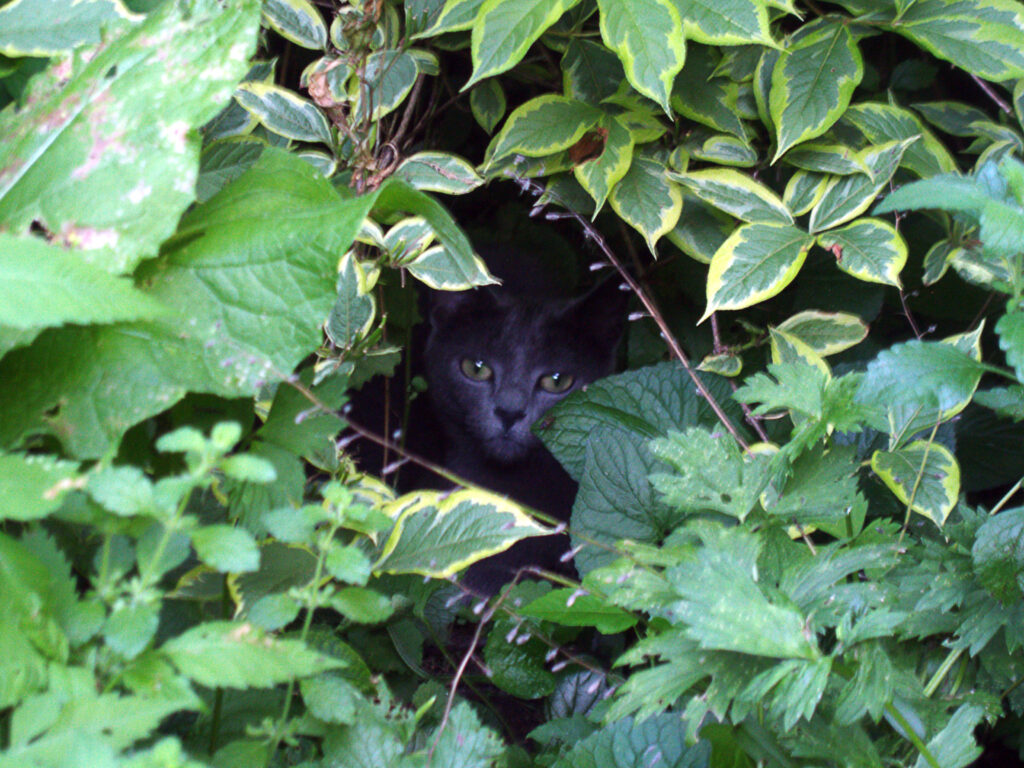By Bernadette Kazmarski
A non-scientific study conducted in 2011 by the Missing Animal Response Network determined that 93% of escaped indoor-only cats were found hiding within a 3-house radius of their escape point. They partnered with the University of Queensland (Australia) to conduct the first-ever Missing Cat Study to further information about lost cat behavior.
Cats, territory and behavior
Your cat’s territory isn’t a turf it protects, it’s a safe space they defined by determining predators can’t get to them, food and water are available and the natives are friendly. If something changes or if they are displaced from this territory in any way they may seem to have a total personality change from the cat you know—they have lost their safe space where they know the sounds, smells and expected activities and feel exposed and in danger. A cat’s survival instinct tells it to get into a place where it is protected on all sides from predators, to keep still and quiet.
Indoor-only cats who’ve escaped outside their indoor territory rarely go far at the time they escape—once they find themselves outside their territory they look for a place to quickly hide and stay there, usually in their own yard or a next-door neighbor’s. At this point, you are not looking for a cat on the run—a lost cat—but a cat in hiding—a misplaced cat—so don’t go on a chase, look for clues close to your cat’s territory.
Success in finding your cat and bringing it safely back home depends on narrowing down your search by determining:
- if your cat did escape, and if so, how your cat escaped
- your own knowledge of your cat’s personality
- an understanding of how cats react to finding themselves outside of their territory
- how long it may have been gone
If you can’t find your cat and also can’t find a convincing exit point, your cat may be having a really good nap on the rafters in the basement, be trapped inside a kitchen cabinet, or may have had a sudden medical issue and found a place where it feels safe and may not respond to you. Cats typically hide in tiny dark spaces. Inside or out, it’s very important to use a good flashlight to help highlight details and reflect on their eyes.
Search immediately, then network
- Find the likely exit point for your cat. If you can, confine other pets, leave that point open and accessible to the lost cat. Many cats end up returning to the point they left from and re-entering on their own.
- Search around your home and yard using a flashlight and softly calling your cat’s name. Because cats quickly look for a safe place to hide when they find themselves outside their territory, often in a straight line from the exit, finding how and where your cat escaped will help direct you to a likely area where your cat might be hiding: across the yard from the door, in shrubs around the house, under a porch, steps, or car. Thoroughly inspect every confined space on and around your house.
- Visit neighbors on each side, explain your situation, ask to search their yards as well, giving them a photo of your cat in case they see it in their yard. If you don’t find your cat in that first sweep that doesn’t mean they aren’t there. They may be frightened of even you and their instinct to hide can keep them concealed from you.
- Make “Lost Cat” flyers including a large photo of your cat, your street and city, date missing and contact method. Post them all over your street and also on streets around yours focusing on intersections, and give them to your neighbors. It may seem old-fashioned, but most pets are found with searches and signs in the neighborhood.
- Contact local shelters, police and other authorities that might collect your cat, post your cat’s photo on websites and online groups.
- Borrow or purchase a humane trap and bait it with smelly food in a likely place for your cat, stay near and watch it—never leave a trap unattended. Use a wildlife camera to see if your cat appears, and remember your cat may only come out at night when it’s quiet.
- Choose a place each day to thoroughly search again where your cat might be hiding still using the flashlight and calling softly, approaching from different angles.
- Visit your local shelters in person at least every other day to see the cats who’ve come in as strays. Many shelters do not have stray holds for cats. Descriptions of coat colors and markings vary and if your pet is frightened it may not act like a friendly or socialized cat so it’s best if you visit and see for yourself that your cat is or isn’t there.
Though one of the first recommendations is to place an article outside that has familiar scents for the cat, it isn’t mentioned in most professional pet search tips. It won’t hurt, but the help it might give is negligible and your own familiar scent is all over things outdoors already.
Using the litter box as a scent lure
Placing your cat’s litter box outdoors so they can find their scent from it is not only behaviorally inaccurate it’s also dangerous to your cat. Your inside cat knows its territory is the inside of your house, not the outside. When living outdoors cats will eliminate in areas far from where they live, eat and sleep so they don’t attract predators into their safe place, and aside from boundary marking will cover their waste outdoors because it screams “small defenseless cat” to predators. Your cat has no reason to be attracted to its own scent, but it is likely to attract outdoor cats, dogs and predators who could seriously endanger your cat if it approached its own home.
Resources:
The Missing Pet Partnership website: www.missinganimalresponse.com/kat-albrecht/
Community Cat Coalition of Washington:
https://www.facebook.com/CommunityCatCoalitionWa/posts/911317935676201:0?hc_location=ufi



